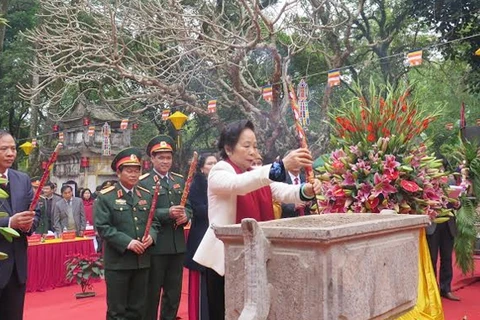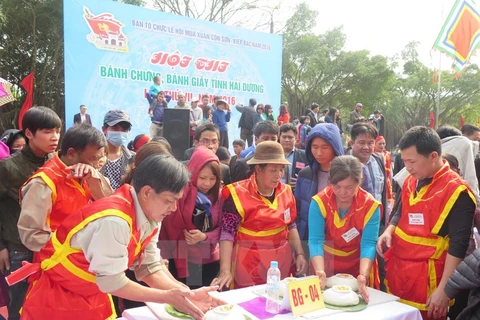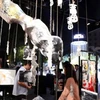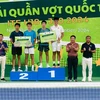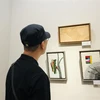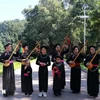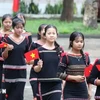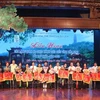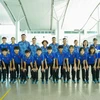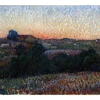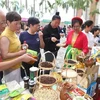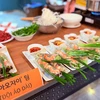Hai Duong (VNA) - The Con Son-Kiep Bac Spring Festival 2017 kicked off in the northern province of Hai Duong on February 12 or the 16th day of the first lunar month.
Taking place from February 12-19, the annual festival aims to commemorate the 683th death anniversary of monk Huyen Quang, who was the third founder of the Truc Lam Zen sect.
Speaking at the opening ceremony, Vice Chairman of the provincial People’s Committee Luong Van Cau highlighted the historical significance of the national heritage site Con Son-Kiep Bac and the great contributions of the Truc Lam Zen sect and monk Huyen Quang to the national construction and defence.
Also at the ceremony, Vice President Dang Thi Ngoc Thinh and local officials cut a ribbon to inaugurate a nine-storey octagonal tower “Cuu Pham Lien Hoa” in the site, which is 10.3metre in height.
The work contributes to preserving and upholding the cultural values of the relic site.
Earlier the same day, a water procession from Con Son Lake to Con Son pagoda drew the participation of hundreds of people. As an important ritual in the Con Son-Kiep Bac festival, it aimed to praise the unity of the community and pray for bumper crop.
Covering a total area of eight hectares in Chi Linh district, the Con Son-Kiep Bac historical site is entwined with the life and cause of general Tran Hung Dao, the Supreme Commander of Vietnam during the Tran Dynasty. It was also where UNESCO’s Great Man of Culture of the World, Nguyen Trai (1380-1442), one of Vietnam’s most famous poets and writers, lived.
The site was a defence line built at the end of the 14th century to protect the Thang Long Imperial Citadel. It witnessed important battles between the Tran Dynasty army and the Yuan-Mongol invaders in the 14th and 15th centuries.
Con Son, surrounded by pine trees, saw the pure and upright life of Nguyen Trai (1380-1442), one of Vietnam’s most famous poets and writers.
Con Son-Kiep Bac was recognised as a national heritage site in 1962 and a special national heritage site in 2012. The Ministry of Culture, Sports and Tourism named the Spring Festival a national intangible cultural heritage one year later.-VNA
Taking place from February 12-19, the annual festival aims to commemorate the 683th death anniversary of monk Huyen Quang, who was the third founder of the Truc Lam Zen sect.
Speaking at the opening ceremony, Vice Chairman of the provincial People’s Committee Luong Van Cau highlighted the historical significance of the national heritage site Con Son-Kiep Bac and the great contributions of the Truc Lam Zen sect and monk Huyen Quang to the national construction and defence.
Also at the ceremony, Vice President Dang Thi Ngoc Thinh and local officials cut a ribbon to inaugurate a nine-storey octagonal tower “Cuu Pham Lien Hoa” in the site, which is 10.3metre in height.
The work contributes to preserving and upholding the cultural values of the relic site.
Earlier the same day, a water procession from Con Son Lake to Con Son pagoda drew the participation of hundreds of people. As an important ritual in the Con Son-Kiep Bac festival, it aimed to praise the unity of the community and pray for bumper crop.
Covering a total area of eight hectares in Chi Linh district, the Con Son-Kiep Bac historical site is entwined with the life and cause of general Tran Hung Dao, the Supreme Commander of Vietnam during the Tran Dynasty. It was also where UNESCO’s Great Man of Culture of the World, Nguyen Trai (1380-1442), one of Vietnam’s most famous poets and writers, lived.
The site was a defence line built at the end of the 14th century to protect the Thang Long Imperial Citadel. It witnessed important battles between the Tran Dynasty army and the Yuan-Mongol invaders in the 14th and 15th centuries.
Con Son, surrounded by pine trees, saw the pure and upright life of Nguyen Trai (1380-1442), one of Vietnam’s most famous poets and writers.
Con Son-Kiep Bac was recognised as a national heritage site in 1962 and a special national heritage site in 2012. The Ministry of Culture, Sports and Tourism named the Spring Festival a national intangible cultural heritage one year later.-VNA
VNA



